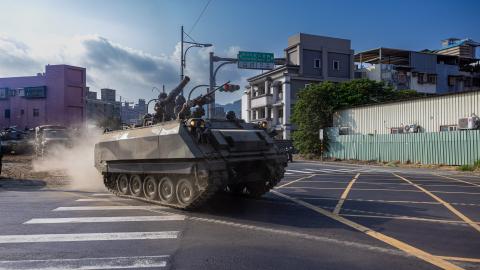Pentagon planning for an emergency evacuation of civilians from Taiwan indicates the Biden administration wants to be ready for a potential clash in East Asia. But the unexpected nomination of Adm. Samuel Paparo to be Chief of Naval Operations (CNO) suggests the White House doesn’t expect war in the Pacific to be imminent.
The CNO is inside-the-Beltway, albeit the Navy’s top desk job. The Commander of the Pacific Fleet is responsible for all U.S. naval forces in the priority theater. Removing a tough warfighter from the most critical operational front-line post, even for the Navy’s top desk assignment, suggests the administration wants to prepare the U.S. Navy for the long game, not the short one.
Ely Ratner, Assistant Secretary of Defense for Indo-Pacific Security Affairs, has been focused from day one on China as the pacing challenge and “a Taiwan contingency as the pacing scenario.”
The twin moves to prepare for a Taiwan contingency while removing one of the Navy’s most formidable commanders from the Pacific is not the contradiction it may appear to some. Rather, it suggests Biden administration officials understand Beijing’s strategy well.
China wants to pressure the United States to stop what it argues is the erosion of the one-China policy. At the same time, it continues to build up the military capabilities that one day might be called on to execute a forceful unification of Taiwan. Meanwhile, China’s resistance to military talks aimed at reducing the likelihood of a mishap from triggering a conflict underscores the need for vigilance.
Chinese President Xi Jinping equates the unification of Taiwan with the “essence” of China’s great rejuvenation. While his military actions and political proclamations increasingly incite alarm — and indeed are so intended — Xi’s immediate interest is to curb support for Taiwan’s de facto independence.
Last August and this April, following the visit to Taiwan by then-House Speaker Nancy Pelosi (D-Calif.) and President Tsai Ing-wen’s transit through the United States, the People’s Liberation Army (PLA) conducted provocative drills simulating military attacks on the island democracy and the imposition of a maritime blockade that would choke off Taipei’s vital supply lines.
The Biden administration’s repeated calls for direct military-to-military talks to establish guardrails that might prevent inadvertent escalation have been emphatically rebuffed. At the recent Shangri-La Dialogue in Singapore, General Li Shangfu, China’s defense minister, offered his American counterpart, Defense Secretary Lloyd Austin, only a handshake.
That U.S.-China ministerial photo-op was choreographed in Beijing to be bookended between unsafe military maneuvers designed to signal Beijing’s mounting clout. On May 26, a PLA Air Force fighter jet flew directly in front of the nose of a U.S. Air Force reconnaissance plane flying in international airspace over the South China Sea. Then, with the Shangri-La Dialogue underway, a PLA Navy combatant dangerously veered across the bow of a U.S. destroyer passing through the Taiwan Strait, missing the U.S. ship by only 150 yards.
Xi is hoping to get a reaction out of regional actors. For example, Xi would love for more countries to emulate French President Emmanuel Macron, who, upon completing a resplendent state visit to China in April, told reporters on the flight back to Paris that Europe should avoid being pulled into a conflict over Taiwan.
The United States can ill afford to be a neutral bystander. Taiwan faces a crucial election in January, and it is counting on the United States to live up to its commitment to ensure no unilateral change to the status quo through force or coercion. National security adviser Jake Sullivan provided the most articulate support for that position in an interview with Fareed Zakaria that aired on the anniversary of the Tiananmen Square massacre.
Despite Pentagon preparation for a mass civilian evacuation from Taiwan, an all-out military invasion of the island democracy is not Beijing’s preferred approach. But a protracted Taiwan crisis that could escalate with little notice makes planning for a noncombatant evacuation operation (NEO) a prudent precaution.
China’s preparation for a possible invasion of Taiwan — even if only intended to signal Beijing’s political will and influence others — requires precautions. While militaries strengthen deterrence, they also must update plans to evacuate civilians in an emergency. Planning for an NEO signals U.S. allies that it is serious about not shying away from a confrontation, even if it means moving civilians from the potential battlefield.
A crisis evacuation of civilians from Taiwan would not be limited to Americans or other foreigners on the island. Tokyo also would have the Self-Defense Forces prepared to evacuate as many as 100,000 Japanese in Okinawa prefecture should conflict break out or appear likely.
The twin moves of evacuation planning and promoting the Navy’s premier warfighter to help train and equip tomorrow’s maritime force suggests the Biden administration is preparing for the worst but planning to remain the best.















